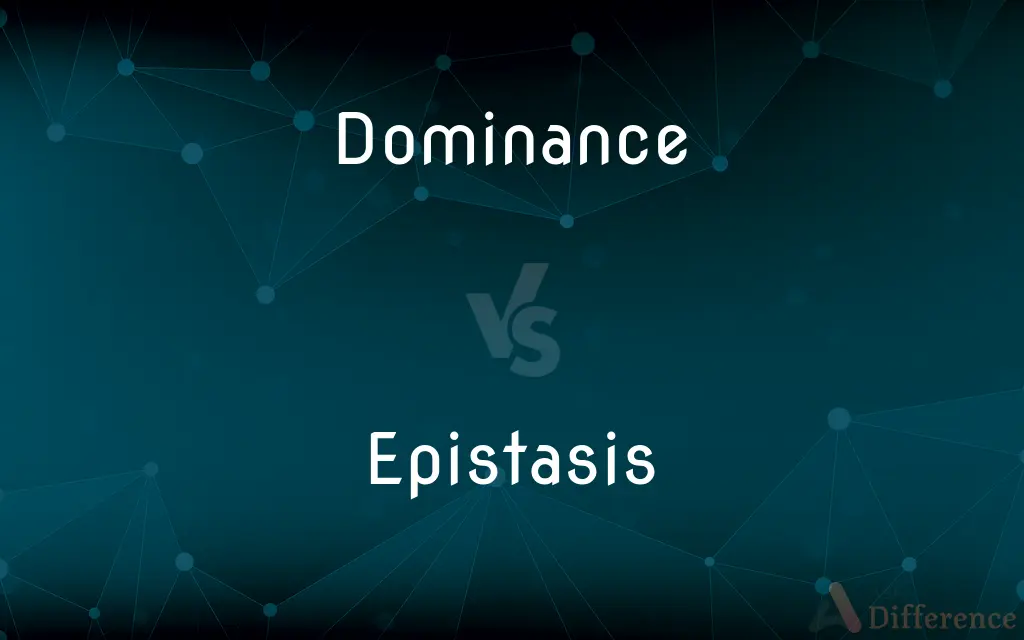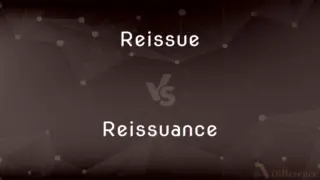Dominance vs. Epistasis — What's the Difference?
By Tayyaba Rehman — Updated on September 23, 2023
Dominance refers to an allele masking another's expression, while epistasis involves one gene affecting the expression of another separate gene.

Difference Between Dominance and Epistasis
Table of Contents
ADVERTISEMENT
Key Differences
Dominance and epistasis are two distinct concepts in genetics, although both deal with the expression of phenotypic traits. Dominance occurs when two different alleles for a single gene are present, and one allele, the dominant one, masks the expression of the other, the recessive. For instance, in the classic Mendelian pea plants, the allele for purple flowers is dominant over the white allele.
On the other hand, epistasis is when the expression of one gene is influenced or masked by another, separate gene. This means that the effects of epistasis can override standard dominance patterns, leading to unique phenotypic outcomes. For example, in some animals, a gene determining coat color might be overridden by another gene that determines if pigment is produced at all.
Dominance is straightforward in its expression, relying on the interplay of just two alleles of a single gene. The dominant allele shows its trait, while the recessive allele's trait appears only when two copies are present. Conversely, epistasis adds a layer of complexity because it involves interactions between different genes, not just alleles.
It's crucial to understand the distinction between dominance and epistasis. While dominance plays out within a single gene's alleles, epistasis involves broader genetic interactions. Recognizing these differences allows for a deeper understanding of the intricate patterns of inheritance and trait expression in organisms.
Comparison Chart
Definition
Interaction of alleles within a gene
Interaction between separate genes
ADVERTISEMENT
Result
One allele masks another
One gene masks or affects another gene's expression
Level of Complexity
Involves two alleles of a single gene
Involves multiple genes
Example
Purple and white pea flowers
Coat color affected by pigment production
Phenotypic Outcomes
Dominant or recessive traits
Can override standard dominance patterns
Compare with Definitions
Dominance
A relationship between alleles of a single gene.
Because of dominance, a heterozygous individual might display only one observable trait.
Epistasis
Interaction between different genes affecting phenotypic expression.
Epistasis can lead to unexpected outcomes in genetic crosses.
Dominance
Contrasts with recessiveness in gene expression.
Due to dominance, certain inherited diseases only manifest when two recessive alleles are inherited.
Epistasis
Can override regular dominance patterns.
Epistasis explains why some predicted phenotypes do not appear in genetic experiments.
Dominance
A hierarchy in allele expression.
The concept of dominance explains why some traits are more common than others.
Epistasis
A masking effect one gene has over another.
Through epistasis, a gene can prevent another from determining a specific trait.
Dominance
A genetic scenario where one allele masks another.
In Mendelian genetics, the dominant allele determines the phenotype.
Epistasis
Complex interplay between multiple genes.
Geneticists study epistasis to understand intricate inheritance patterns.
Dominance
Refers to the allele that expresses its trait in the presence of another.
Dominance determines which trait appears when two different alleles are present.
Epistasis
A non-allelic form of gene interaction.
Epistasis can create challenges in predicting genetic outcomes.
Dominance
The condition or fact of being dominant.
Epistasis
Epistasis is a phenomenon in genetics in which the effect of a gene mutation is dependent on the presence or absence of mutations in one or more other genes, respectively termed modifier genes. In other words, the effect of the mutation is dependent on the genetic background in which it appears.
Dominance
The state of being dominant; of prime importance; supremacy.
Epistasis
An interaction between nonallelic genes in which the genotype at one locus affects the expression of alleles at another locus.
Dominance
Being in a position of power, authority or ascendancy over others.
Epistasis
A film that forms over the surface of a urine specimen.
Dominance
(physiology) The superior development of or preference for one side of the body or one of a pair of organs; such as being right-handed.
Epistasis
The suppression of a bodily discharge or secretion.
Dominance
The property of a gene such that it suppresses the expression of its allele.
Epistasis
(genetics) The modification of the expression of a gene by another unrelated one.
Dominance
Predominance; ascendency; authority.
Epistasis
The suppression of a gene by the effect of an unrelated gene
Dominance
Superior development of one side of the body
Dominance
The state that exists when one person or group has power over another;
Her apparent dominance of her husband was really her attempt to make him pay attention to her
Dominance
The power or right to give orders or make decisions;
He has the authority to issue warrants
Deputies are given authorization to make arrests
Common Curiosities
How does epistasis differ from dominance?
Epistasis is when the expression of one gene is influenced or masked by another separate gene.
Which involves multiple genes, dominance or epistasis?
Epistasis involves interactions between different genes.
What does dominance refer to in genetics?
Dominance is when one allele masks the expression of another allele for the same gene.
Does dominance involve separate genes?
No, dominance refers to the interaction of alleles within a single gene.
Can two dominant alleles be epistatic to each other?
It's typically one gene being epistatic to another, not individual alleles.
Can a dominant allele be masked by another gene?
Yes, through epistasis, a gene can mask the effects of a dominant allele of another gene.
How can epistasis affect genetic counseling?
Epistasis can introduce complexities in predicting inheritance patterns for certain traits.
Is dominance always complete?
No, there can also be incomplete dominance where neither allele is completely dominant.
Can epistasis change expected phenotypic ratios?
Yes, epistasis can override expected ratios based on dominance alone.
What’s an example of epistasis in animals?
In certain dogs, one gene determining fur color can be overridden by another controlling fur color presence.
Is epistasis common in genetic crosses?
While it can occur, simple dominance is more commonly observed.
Can epistasis make genetic predictions more challenging?
Yes, because it introduces another layer of gene interactions beyond standard dominance.
Why is understanding dominance essential in genetics?
Dominance helps predict genetic outcomes based on allele relationships.
Do all genes exhibit dominance?
Not all; some genes display incomplete dominance or co-dominance.
Share Your Discovery

Previous Comparison
Reissue vs. Reissuance
Next Comparison
Cathode vs. AnodeAuthor Spotlight
Written by
Tayyaba RehmanTayyaba Rehman is a distinguished writer, currently serving as a primary contributor to askdifference.com. As a researcher in semantics and etymology, Tayyaba's passion for the complexity of languages and their distinctions has found a perfect home on the platform. Tayyaba delves into the intricacies of language, distinguishing between commonly confused words and phrases, thereby providing clarity for readers worldwide.














































